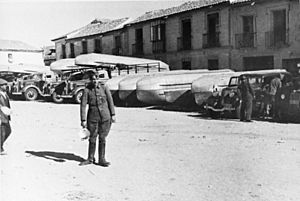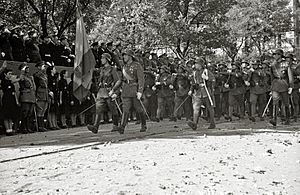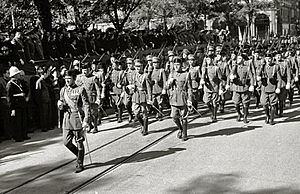Spanish Armed Forces during the period of Francoism facts for kids
Quick facts for kids Spanish Armed ForcesFuerzas Armadas de España |
|
|---|---|
| Flag of Spain (1945–1977).svg Flag of Spain (1945–1977) |
|
| Established | 1939 |
| Current form | Spanish Armed Forces |
| Disbanded | 1975 |
| Parts | Spanish Army Spanish Navy Spanish Air Force Civil Guard Armed Police |
| Leadership | |
| Commander-in-chief | Francisco Franco |
| Minister of the Navy | See list |
| Chief of the Defence High Command | See list |
| See also | |
| Ranks | Military ranks of the Spanish State |
During the time of Francoism, the Spanish Armed Forces were in charge of defending Spain and keeping public order. This was when Spain was led by General Francisco Franco. Their story begins with the Spanish Civil War in 1936. It continues through Franco's rule until his death in 1975 and the start of democracy in 1978.
During the Civil War and Franco's rule, these forces were called the National Army or Spanish Army. Because they were very loyal to Franco, they were also known as the Francoist Army. They were a key part of Franco's power. They stayed important even after he died, until Spain became a democracy again.
The army started with the groups that rose up against the government in 1936. This started the Civil War. After Franco won, the army's structure changed. It became more organised like a government department. Some historians have pointed out that the army often lacked enough supplies. There were also problems with corruption, which means people used their positions unfairly. This made it harder for the Spanish Armed Forces to be a modern army. Instead, they often acted more like a police force to support Franco's government.
Contents
The Spanish Armed Forces Under Franco
How the Army Supported Franco's Power
During the Civil War, the Army became the main part of the new government led by General Franco. This continued after they won the war. The army was involved in many parts of society. For example, the newspaper Arriba became a way for the Armed Forces to share information.
The armed forces also helped keep control during Franco's rule. They were very active, especially in the early years. As the supreme commander, Franco made the final decisions on important matters.
The Armed Forces worked closely with Franco's government. They had power in how the country was run. They also influenced the government and state offices. The Army controlled the police forces, and many army officers worked in public administration. They were also involved in state-owned companies.
Many Officers, Less Equipment
In 1968, the Army Ministry spent most of its money on salaries for its staff. Only a small part was used for new equipment and technology. The Navy and Air Force ministries also spent a lot on salaries. The security forces, like the General Police Corps, Armed Police Corps, and Guardia Civil, also had many officers.
By 1970, there were still many officers in the armed forces. Out of about 289,000 members, 824 were high-ranking generals. Many officers earned low salaries. Because of this, they often had other jobs in the government or private companies.
How the Army Developed
The Army's Beginnings in 1936
Before the Spanish Civil War began in 1936, the Spanish Army was divided into eleven areas. Eight were regular divisions, three were military commands, and one was in Morocco. When the war started, this structure broke apart.
After the coup in July 1936, the rebel side had more soldiers and officers than the government side. The rebel side also had the Spanish Army of Africa. This was Spain's most skilled military unit, with a lot of combat experience. Most generals stayed loyal to the government, but many mid-level officers joined the rebels. The number of rebel officers grew during the war. Most officers in Spain in 1936 supported the coup. They had a conservative and military mindset.
The rebel plans did not fully succeed at first. But by September, it looked like the rebels were winning. On September 28, military leaders of the rebel side met. They chose General Francisco Franco as the leader of their armies and head of state. Franco believed his forces were strong enough to win the war quickly.
On October 1, Franco became the new leader in Burgos. He focused on setting up the new rebel government. He created the Armies of the Norte (North) and Sur (South). These were the largest military units. General Queipo de Llano led the Army of the South. Brigadier General Emilio Mola Vidal led the Army of the North. Other leaders were appointed for different roles, like in Morocco and for the Navy and Air Force.
The Spanish Civil War (1936-1939)
From April 1937, the war became longer than expected. The army divisions were renamed Army Corps and focused on different parts of the front lines. The old military regions were also slowly brought back.
By March 1937, the rebel forces had about 300,000 men. By the end of the year, they had 500,000 soldiers. This number was a bit less than the government's army. Many of these soldiers were people who had been captured or forced to join. But there were also many volunteers. The Spanish Army of Africa, including the Spanish Legion and the Regulares, were also part of Franco's army. These units were very experienced. All these troops were organised into divisions.
The rebels won a big victory in the North. This allowed their navy to move to the Mediterranean Sea. Also, 65,000 men from the Army of the North became available. These forces helped in the Aragon Offensive in March 1938. This offensive reached the Mediterranean Sea, splitting the government's territory in two. Later, the rebels tried to attack Valencia, but they failed. In July, the government launched an attack on the Ebro River. This surprised Franco's army. But after many bloody counterattacks, the government forces had to retreat.
By the end of 1938, the rebel army had over a million soldiers. This included most men aged 18 to 31. The army was divided into four main groups. These were the Army of the South, the Army of the Centre, the Ejército del Norte, and the Ejército de Levante. At this point, the government forces were very tired and had few reserves. In December, the Catalonia Offensive began. This ended in February 1939 with a big victory for Franco's forces. On March 26, the final attack of the Civil War began. Franco's armies advanced easily. On March 31, the port of Alicante, the last place not captured, surrendered. This officially ended the Civil War.
After the War and During World War II
After the Civil War, the Army had many soldiers. But they lacked good air support, tanks, and modern equipment. In the summer of 1939, the army was made smaller. However, with World War II starting, Franco kept a large army of over 500,000 soldiers. This was very expensive for Spain, which was still recovering from the Civil War. The army's spending took up a huge part of the national budget.
Franco wanted to join World War II. But many generals did not agree. They thought it was too risky because the army had many problems. Reports from the General Staff showed how weak the armed forces were. They also pointed out that the Spanish people were exhausted. Franco met with German leaders, but Spain did not officially join the war.
During World War II, some Spanish generals worked secretly with British intelligence. They shared information about Franco's army. There were also problems with corruption within the army. This happened even though the armed forces faced economic difficulties.
Groups fighting against Franco, called the Maquis, were active. The government called them bandits. But they caused the army and Guardia civil to use many forces against them. This led to harsh actions against the guerrillas and their supporters.
Where the Army Got Its Weapons
During the Spanish Civil War, the rebel army got most of its weapons from Italy and Nazi Germany. So, they did not need to make many weapons in their own factories. However, some factories did make explosives and ammunition. For example, Hispano-Suiza built a factory in Seville to fix fighter planes.
By the end of the war, Germany had sent about 200 Panzer I tanks and 600 aircraft. This included many Messerschmitt Bf 109 and Heinkel He 111 planes. They also sent artillery. Italy sent even more aircraft, like Fiat CR 32 fighters, and 800 pieces of artillery. They also sent 150 tanks. In total, many engines, machine guns, rifles, and vehicles were sent.
After the Civil War, the new Air Minister, Juan Yagüe, wanted to build a new Air Army. He hoped Germany and Italy would help. He wanted this new air force to join World War II with the Axis powers. But this plan failed because Spain was in a difficult situation.
In 1943, Spain talked with the German Army about buying more equipment. Germany offered to sell 20 Panzer IV tanks and other materials. Spain accepted this offer. In 1944, Spain tried to buy more equipment from Germany, but it did not happen.
In 1953, the United States and Spain signed a military aid treaty. The US gave weapons and technology to the Spanish armed forces. Later, in 1962, the Navy Minister, Pedro Nieto Antúnez, wanted to build many new ships. This was a very big plan. A smaller plan was approved in 1963 to buy a light cruiser and five frigates. But the British government refused to sell the frigates to Franco's government. So, Spain had to build the ships itself.
The US did not allow Spain to use US weapons in the Ifni War. This made Spain look for other countries to buy weapons from. In the 1960s, Spain talked with France and Germany. They wanted to buy tanks like the AMX-30 or the Leopard 1. Germany could not sell the Leopard tank because its gun system was British. The British government again refused to sell weapons to Franco's government. So, in May 1970, Spain and France agreed on the sale of 19 AMX-30 tanks. These tanks were sent to the Spanish Legion in the Spanish Sahara. From 1974, Spain started making its own AMX-30 tanks, called AMX-30E. They made 180 of these tanks until 1979.
Military Leaders
On January 31, 1938, General Fidel Dávila Arrondo became the Minister of National Defence. He was in charge of the Army, Navy, and Air Force. But after the Civil War ended, in August 1939, this ministry was split. Separate ministers were appointed for the Army, Navy, and Air Force.
Images for kids
See also
 In Spanish: Fuerzas Armadas Españolas (período del franquismo) para niños
In Spanish: Fuerzas Armadas Españolas (período del franquismo) para niños











